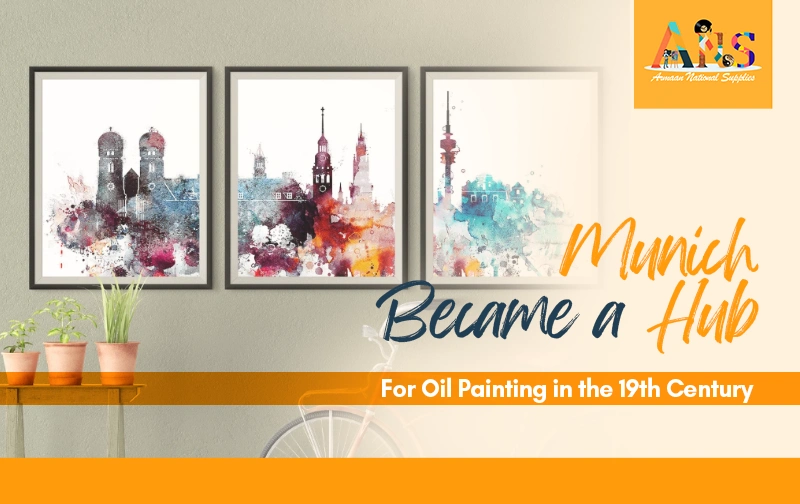LET'S REVIVE YOUR WALL
How Munich Became a Hub for Oil Painting in the 19th Century
- Home
- Blog Detail

How Munich Became a Hub for Oil Painting in the 19th Century
- January 15, 2025,
The 19th century was a transformative period for art in Europe, and Munich emerged as a key player in the world of oil painting. Known for its rich cultural heritage, vibrant art scene, and prestigious academies, Munich became a magnet for artists seeking inspiration and training. The city’s contributions to oil painting continue to influence the art world today. Let’s explore how Munich earned its reputation as a hub for oil painting during this golden era.
The Rise of Munich as an Artistic Center
Munich’s journey to becoming a hub for oil painting began with its status as the capital of Bavaria. By the early 19th century, the city was already renowned for its architectural beauty and cultural institutions. Under the patronage of Bavarian royalty, Munich invested heavily in the arts, establishing itself as a center of creativity and innovation.01. The Role of the Royal Academy of Fine Arts
- Founded in 1808, the Royal Academy of Fine Arts in Munich played a pivotal role in shaping the city’s artistic identity.
- The academy attracted aspiring painters from across Europe, offering rigorous training in techniques like oil painting landscapes and realistic portrayals.
- Many famous artists, such as Franz von Lenbach and Wilhelm Leibl, trained here, contributing to the city’s reputation.
02. Patronage and Support
- Bavarian kings like Ludwig I were passionate about art, commissioning works and supporting artists.
- The establishment of galleries, such as the Alte Pinakothek in 1836, provided a venue to showcase both contemporary and historical masterpieces, inspiring emerging talents.
Munich’s Distinctive Style of Oil Painting
Munich’s artists developed a distinctive style that combined traditional techniques with innovative approaches. The city became synonymous with rich, vibrant palettes and meticulous attention to detail. Popular themes included realistic oil painting landscapes, portraits, and historical scenes.01. The Munich School
- This term refers to a group of 19th-century painters who were deeply influenced by the city’s artistic environment.
- Known for their realism and emotional depth, Munich School artists often depicted rural life, capturing the essence of Bavarian culture.
02. Oil Painting Landscapes
- Munich’s proximity to the Bavarian Alps and picturesque countryside inspired countless oil painting landscapes.
- These works often featured dramatic skies, lush greenery, and intricate details that conveyed the region’s natural beauty.
03. Influence on Realism
- The city’s artists were instrumental in the rise of realism, emphasizing lifelike depictions and everyday subjects.
- This approach influenced movements like the Barbizon School in France and paved the way for modern art.
Key Artists and Their Contributions
Munich’s prominence as an oil painting hub was cemented by the contributions of several iconic artists:01. Franz von Lenbach
- Known for his portraits, Lenbach’s work exemplified the Munich School’s commitment to realism.
- His paintings often featured prominent figures, showcasing his mastery of detail and texture.
02. Wilhelm Leibl
- A leader in realism, Leibl’s works captured the authenticity of rural life.
- His meticulous technique influenced generations of artists seeking to perfect realistic oil painting landscapes.
03. Hans Makart
- Celebrated for his grandiose historical scenes, Makart’s dramatic style brought Munich international acclaim.
Munich Oil Painting’s Global Influence
Munich’s impact extended far beyond its borders. The techniques and styles developed here influenced artists worldwide, particularly in the United States and other parts of Europe.01. Art Academies
- Many international students trained in Munich, bringing its methods back to their home countries.
- The city’s focus on realism and landscapes resonated with artists seeking to capture their own environments.
02. Oil Paintings for Sale
- Munich became a hub for art collectors, with galleries and markets offering famous oil paintings and emerging works.
- Today, you can still find vintage oil painting landscapes inspired by Munich’s traditions.
03. Modern Connections
- Suppliers like Armaan National Supplies offer tools and materials that uphold Munich’s legacy in oil painting.
- Whether you’re a collector or an artist, Munich’s influence remains accessible through oil paintings for sale worldwide.
Benefits of Exploring Munich’s Oil Painting Legacy
Understanding Munich’s contributions to oil painting offers several benefits:01. Inspiration for Artists
- The city’s techniques and styles provide a foundation for aspiring painters.
- Studying works from Munich can inspire easy oil painting landscapes and more complex projects.
02. Cultural Appreciation
- Exploring Munich’s art history deepens one’s appreciation for European culture and heritage.
03. Investment Opportunities
- Collectors can find valuable pieces, from realistic oil painting landscapes to famous oil paintings, enriching their collections.

